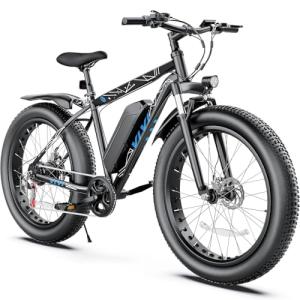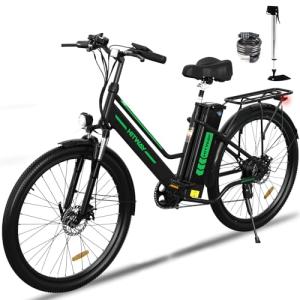Introduction
In an age where sustainable transportation options are increasingly in demand, electric bicycles have emerged as a formidable contender, revolutionizing the way adults commute, exercise, and explore the world around them. This article delves into the phenomenon of electric bicycles for adults, exploring their evolution, advantages, challenges, and the impact they have on our society.
The Rise of Electric Bicycles
Electric bicycles, once considered a niche market, have experienced a remarkable surge in popularity over the past decade. With advancements in battery technology, motor efficiency, and design aesthetics, electric bikes have transcended their traditional image, appealing to a broader demographic beyond just cycling enthusiasts. The rise of electric bicycles represents a shift towards sustainable and efficient modes of transportation, addressing the dual concerns of environmental impact and personal mobility.
Purpose and Scope of the Article
This article aims to provide a comprehensive examination of electric bicycles for adults, shedding light on their significance in modern transportation, health, and urban planning. By exploring the technological intricacies, societal implications, and market dynamics, this piece seeks to offer readers a nuanced understanding of electric bicycles and their place in the contemporary landscape.
Overview of Electric Bicycle Technology
At the heart of electric bicycles lies a fusion of traditional cycling components with cutting-edge technology. From lithium-ion batteries to brushless motors, electric bicycles integrate a myriad of sophisticated elements to deliver seamless and efficient performance. Understanding the mechanics behind electric bicycles is essential for appreciating their functionality, safety considerations, and potential for further innovation. This section provides a foundational overview of electric bicycle technology, setting the stage for deeper exploration in subsequent sections of the article.
Historical Context
Electric bicycles, while emblematic of modern innovation, are rooted in a rich historical tapestry that spans centuries of human ingenuity and technological progress. This section delves into the historical context surrounding the evolution of bicycle design, the emergence of electric bicycles, and the early adoption and growth trends that have shaped their trajectory.
Evolution of Bicycle Design
The history of bicycles traces back to the early 19th century, with the invention of the "velocipede" or "dandy horse" by Karl Drais in 1817. This rudimentary precursor to the modern bicycle featured a wooden frame, two wheels, and no pedals, requiring riders to propel themselves forward by pushing off the ground with their feet. Over the ensuing decades, numerous inventors and innovators refined the design, introducing crucial advancements such as pedals, chains, pneumatic tires, and lightweight materials.
By the late 19th century, bicycles had evolved into the recognizable form we know today, characterized by a diamond-shaped frame, pneumatic tires, and a chain-driven drivetrain. The popularity of bicycles soared during this period, ushering in a golden age of cycling culture and innovation.
Emergence of Electric Bicycles
The concept of electric bicycles dates back to the late 19th century, with early prototypes featuring cumbersome lead-acid batteries and primitive electric motors. However, it wasn't until the late 20th century that electric bicycles began to gain traction as a viable alternative to traditional pedal-powered bikes.
Advancements in battery technology, motor efficiency, and regulatory frameworks paved the way for the commercialization of electric bicycles in the late 20th and early 21st centuries. These developments allowed manufacturers to produce electric bicycles that offered meaningful assistance to riders while maintaining the familiar form factor and functionality of traditional bicycles.
Early Adoption and Growth Trends
The early adoption of electric bicycles was initially confined to niche markets and enthusiast communities. However, as battery technology improved and prices began to decline, electric bicycles gradually entered the mainstream, appealing to a broader demographic of commuters, recreational cyclists, and outdoor enthusiasts.
In recent years, the growth of the electric bicycle market has been exponential, with sales skyrocketing in regions around the world. Factors such as increasing urbanization, rising fuel costs, and a growing awareness of environmental sustainability have fueled this growth, positioning electric bicycles as a compelling solution to the challenges of modern transportation.
As electric bicycles continue to evolve and gain acceptance, their impact on mobility, health, and urban infrastructure is poised to become increasingly significant, shaping the way we move and interact with our environment in the decades to come.
The Mechanics of Electric Bicycles
Electric bicycles represent a harmonious blend of traditional cycling components and sophisticated electronic systems, seamlessly integrated to deliver enhanced performance and efficiency. This section delves into the mechanics of electric bicycles, exploring the key components, battery technology, motor systems, and the seamless integration of electric and traditional elements.
Components and Design
Electric bicycles share many components with their traditional counterparts, including frames, wheels, brakes, and drivetrains. However, they also incorporate specialized components such as electric motors, controllers, and battery packs. The design of electric bicycles varies widely depending on factors such as intended use, terrain, and rider preferences. Some models feature sleek, minimalist designs, while others prioritize comfort and utility.
Battery Technology
At the heart of every electric bicycle lies a rechargeable battery pack, which serves as the primary power source for the electric motor. Modern electric bicycles predominantly utilize lithium-ion battery technology due to its high energy density, lightweight construction, and long cycle life. These battery packs are available in various capacities, ranging from small, lightweight units suitable for short commutes to larger, high-capacity batteries capable of providing extended range.
Motor Systems
Electric bicycles are equipped with electric motors that provide assistance to the rider during pedaling. These motors come in a variety of configurations, including hub motors, mid-drive motors, and crank motors. Hub motors are integrated into the wheel hub and provide direct drive propulsion, while mid-drive motors are mounted on the frame near the bottom bracket, leveraging the bike's gearing system for increased efficiency. Crank motors, also known as pedal-assist motors, are positioned near the bike's pedals and provide assistance based on the rider's pedaling cadence and force.
Integration of Electric and Traditional Components
One of the key challenges in designing electric bicycles is seamlessly integrating electric and traditional components to ensure optimal performance and usability. Manufacturers must carefully balance factors such as weight distribution, aerodynamics, and handling characteristics to create a cohesive and intuitive riding experience. This integration extends beyond mere functionality, encompassing considerations such as aesthetics, ergonomics, and user interface design.
By carefully balancing the design and integration of electric and traditional components, electric bicycles offer a compelling combination of convenience, efficiency, and versatility, empowering riders to explore new horizons and embrace sustainable transportation options with confidence.
Advantages of Electric Bicycles for Adults
Electric bicycles offer a myriad of advantages for adults seeking sustainable and efficient modes of transportation, recreation, and exercise. This section explores the various benefits of electric bicycles, ranging from health improvements to economic savings and enhanced mobility.
Health Benefits
Electric bicycles provide adults with a unique opportunity to incorporate physical activity into their daily routines without the barriers associated with traditional cycling. By offering adjustable levels of assistance, electric bicycles accommodate riders of varying fitness levels and abilities, making it easier for individuals to engage in regular exercise and improve their overall health. Additionally, electric bicycles encourage outdoor activity and exploration, fostering a greater connection with nature and the surrounding environment.
Environmental Impact
Electric bicycles represent a cleaner and greener alternative to traditional motorized transportation options, significantly reducing greenhouse gas emissions, air pollution, and noise pollution. By leveraging electric power, riders can commute to work, run errands, and travel short distances without relying on fossil fuels or contributing to traffic congestion. Furthermore, the environmental benefits of electric bicycles extend beyond individual riders, contributing to broader initiatives aimed at combating climate change and promoting sustainable urban development.
Economic Considerations
From a financial perspective, electric bicycles offer substantial cost savings compared to traditional automobiles, motorcycles, and public transportation. With lower operating costs and minimal maintenance requirements, electric bicycles are an affordable and sustainable transportation solution for adults living in urban, suburban, and rural environments alike. Additionally, electric bicycles reduce reliance on expensive fuel sources and parking fees, freeing up disposable income for other necessities or leisure activities.
Accessibility and Mobility
One of the most significant advantages of electric bicycles is their ability to enhance accessibility and mobility for adults of all ages and abilities. Whether overcoming physical limitations, navigating challenging terrain, or extending commuting distances, electric bicycles empower individuals to travel farther, faster, and with greater ease than ever before. Moreover, electric bicycles provide a viable transportation option for individuals who may not possess a driver's license, lack access to public transportation, or face barriers to traditional cycling due to age or health concerns.
By harnessing the power of electric propulsion, bicycles have evolved into versatile and inclusive vehicles that promote personal health, environmental stewardship, financial savings, and social equity. As the popularity of electric bicycles continues to grow, their transformative impact on the way adults move and interact with their surroundings will only become more pronounced, shaping the future of urban mobility and sustainable transportation.
Addressing Concerns and Misconceptions
Electric bicycles have gained popularity rapidly, but along with their rise, concerns and misconceptions have emerged. This section addresses some of the most common issues, including safety considerations, regulatory challenges, and maintenance concerns.
Safety Considerations
While electric bicycles offer numerous benefits, safety remains a paramount concern for riders and pedestrians alike. One of the primary safety considerations is the increased speed and power capabilities of electric bicycles, which may catch riders off guard if they are not accustomed to handling such vehicles. Additionally, the integration of electric components introduces new risks, such as potential malfunctions or failures of electrical systems.
To mitigate safety risks, riders should prioritize proper training and familiarization with their electric bicycles, including understanding how to operate the motor system, brakes, and other essential components safely. Wearing protective gear, such as helmets and reflective clothing, can also enhance rider safety and visibility, especially when riding in urban environments or at night.
Regulatory Issues and Legal Framework
The growing popularity of electric bicycles has prompted policymakers and regulatory agencies to establish guidelines and regulations to ensure their safe and responsible use. However, navigating the legal landscape surrounding electric bicycles can be complex, as regulations vary widely from region to region.
Common regulatory issues include determining where electric bicycles are permitted to operate, defining speed limits and power thresholds, and clarifying the rights and responsibilities of electric bicycle riders in relation to other road users. Additionally, the classification of electric bicycles may differ between jurisdictions, leading to confusion and inconsistencies in enforcement.
Addressing regulatory challenges requires collaboration between stakeholders, including government agencies, advocacy groups, and industry representatives, to develop clear and comprehensive frameworks that balance safety, accessibility, and innovation.
Maintenance and Longevity
Like traditional bicycles, electric bicycles require regular maintenance to ensure optimal performance and longevity. However, the integration of electric components adds an additional layer of complexity to maintenance procedures.
Common maintenance tasks for electric bicycles include inspecting and servicing the battery, motor, drivetrain, and braking systems, as well as checking for loose connections, worn components, and signs of damage or corrosion. Proper storage and charging practices are also essential for preserving battery health and maximizing lifespan.
While electric bicycles may require more specialized maintenance than their non-electric counterparts, routine upkeep and preventative measures can help extend the lifespan of electric bicycles and minimize the risk of unexpected breakdowns or malfunctions.
By addressing concerns and misconceptions related to safety, regulation, and maintenance, stakeholders can promote the safe and responsible use of electric bicycles while maximizing their potential to improve mobility, sustainability, and quality of life for riders and communities alike.
Market Trends and Consumer Behavior
Understanding market trends and consumer behavior is essential for assessing the current landscape and predicting future developments in the electric bicycle industry. This section examines market analysis, growth projections, target demographics, user profiles, consumer preferences, and customization trends.
Market Analysis and Growth Projections
The electric bicycle market has experienced significant growth in recent years, driven by increasing demand for sustainable transportation solutions, advancements in technology, and shifting consumer preferences. Market analysis indicates a steady upward trajectory, with global sales expected to continue rising as awareness and adoption rates increase.
Factors contributing to market growth include urbanization, rising fuel costs, environmental concerns, and government incentives for electric mobility. Additionally, technological innovations such as improved battery efficiency, lighter materials, and enhanced connectivity features are expanding the appeal of electric bicycles to a broader range of consumers.
Target Demographics and User Profiles
Electric bicycles appeal to a diverse range of demographics, including commuters, recreational cyclists, outdoor enthusiasts, and seniors. While traditional bicycles have historically attracted a predominantly male, younger demographic, electric bicycles are gaining traction among women, older adults, and individuals with varying levels of cycling experience.
User profiles vary based on factors such as age, income level, geographic location, lifestyle preferences, and transportation needs. Commuters may prioritize features such as range, comfort, and portability, while recreational cyclists may prioritize performance, versatility, and off-road capabilities.
Consumer Preferences and Customization Trends
Consumer preferences for electric bicycles are influenced by a variety of factors, including design aesthetics, technological features, brand reputation, price point, and after-sales support. Customization trends reflect a desire for personalized experiences and unique styling options, with manufacturers offering a range of color choices, accessory packages, and upgrade options to cater to individual tastes and preferences.
Key customization trends include the integration of smart technology, such as GPS navigation, smartphone connectivity, and health tracking features, as well as the adoption of modular design concepts that allow for easy customization and component upgrades.
As consumer demand for electric bicycles continues to grow, manufacturers are responding with a diverse array of product offerings tailored to different market segments and user preferences. By staying attuned to market trends and consumer behavior, industry stakeholders can anticipate evolving needs and preferences, driving innovation and shaping the future of electric mobility.
Impact on Urban Mobility
Electric bicycles have emerged as a transformative force in urban mobility, offering a sustainable and efficient alternative to traditional modes of transportation. This section explores the impact of electric bicycles on alleviating traffic congestion, their integration with public transportation systems, and the urban planning and infrastructure considerations associated with their proliferation.
Alleviating Traffic Congestion
One of the most significant benefits of electric bicycles is their ability to alleviate traffic congestion in urban areas. By providing an alternative to cars and motorcycles, electric bicycles reduce the number of vehicles on the road, freeing up valuable space and reducing traffic congestion. This not only improves overall traffic flow but also reduces travel times, carbon emissions, and air pollution, contributing to a cleaner and more efficient urban environment.
Electric bicycles are particularly well-suited for short to medium-distance trips, such as commuting to work, running errands, or accessing local amenities. Their compact size and agility enable riders to navigate congested streets, narrow pathways, and crowded urban areas with ease, bypassing traffic jams and gridlock.
Integration with Public Transportation
Electric bicycles complement existing public transportation systems by providing first and last-mile connectivity solutions for commuters. By combining electric bicycles with buses, trains, subways, and other forms of public transit, riders can extend the reach of their journeys, bridging the gap between home, work, and other destinations.
Public transportation agencies are increasingly recognizing the value of integrating electric bicycles into their service offerings, with initiatives such as bike-sharing programs, bike racks on buses and trains, and dedicated bike lanes and infrastructure. These efforts not only enhance the accessibility and convenience of public transportation but also promote multi-modal travel patterns and reduce reliance on private cars.
Urban Planning and Infrastructure Considerations
The widespread adoption of electric bicycles necessitates careful consideration of urban planning and infrastructure requirements to accommodate their unique needs and characteristics. Key considerations include the provision of dedicated bike lanes, bike parking facilities, charging stations, and other amenities tailored to electric bicycle users.
Investments in cycling infrastructure and urban design can enhance safety, accessibility, and comfort for electric bicycle riders, encouraging more people to choose cycling as a viable mode of transportation. Additionally, urban planners should consider the impact of electric bicycles on pedestrian zones, traffic flow, and land use patterns to ensure harmonious integration with existing urban environments.
By embracing electric bicycles as a key component of sustainable urban mobility strategies, cities can reduce congestion, improve air quality, promote active lifestyles, and create more livable and resilient communities for residents and visitors alike.
Community and Social Implications
Electric bicycles have far-reaching community and social implications, fostering connections, promoting active lifestyles, and advancing environmental stewardship. This section explores the role of electric bicycles in facilitating group riding and community engagement, supporting health and wellness initiatives, and driving environmental advocacy and sustainability movements.
Group Riding and Community Engagement
Electric bicycles provide opportunities for individuals to come together and participate in group riding activities, fostering a sense of community and camaraderie among riders. Whether it's organized group rides, cycling clubs, or community events, electric bicycles create shared experiences and promote social interaction among participants.
Group riding not only enhances the enjoyment of cycling but also promotes safety and mutual support, as riders can look out for one another and share knowledge and expertise. Additionally, electric bicycles enable riders of varying abilities and fitness levels to participate in group activities, making cycling more inclusive and accessible to a broader range of individuals.
Community engagement initiatives, such as bike-sharing programs, educational workshops, and advocacy campaigns, further strengthen the bond between electric bicycle riders and their communities, promoting cycling as a sustainable and equitable mode of transportation.
Health and Wellness Initiatives
Electric bicycles play a significant role in promoting health and wellness by encouraging regular physical activity and active transportation behaviors. Unlike traditional bicycles, electric bicycles offer assistance to riders, enabling them to travel longer distances, tackle challenging terrain, and overcome physical barriers with less effort.
Regular cycling has been shown to improve cardiovascular health, boost mental well-being, and reduce the risk of chronic diseases such as obesity, diabetes, and hypertension. Electric bicycles extend these health benefits to a broader demographic of individuals, including seniors, individuals with mobility limitations, and those who may be new to cycling.
Health and wellness initiatives, such as community bike rides, fitness challenges, and corporate wellness programs, leverage the accessibility and appeal of electric bicycles to promote active lifestyles and encourage positive behavior change among participants.
Environmental Advocacy and Sustainability Movements
As symbols of sustainable transportation, electric bicycles play a crucial role in advancing environmental advocacy and sustainability movements. By reducing reliance on fossil fuels, minimizing carbon emissions, and promoting alternative modes of transportation, electric bicycles contribute to efforts to combat climate change and protect the environment.
Environmental advocacy organizations, urban planners, and policymakers recognize the potential of electric bicycles to promote sustainable urban mobility and reduce the ecological footprint of transportation systems. By advocating for policies that support cycling infrastructure, electric bicycle incentives, and sustainable land use practices, these stakeholders can amplify the environmental benefits of electric bicycles and promote a shift towards more sustainable transportation models.
Through community engagement, health and wellness initiatives, and environmental advocacy efforts, electric bicycles empower individuals and communities to embrace sustainable lifestyles, foster social connections, and create healthier, more vibrant communities for future generations.
Case Studies and Success Stories
Electric bicycles have sparked numerous success stories and innovative initiatives across various sectors, from corporate endeavors to personal adventures. This section highlights compelling case studies and success stories, including corporate initiatives, brand successes, personal testimonials, and collaborative projects that showcase the transformative potential of electric bicycles.
Corporate Initiatives and Brand Successes
Leading brands and corporations have embraced electric bicycles as a strategic opportunity to innovate, differentiate, and expand their market reach. Companies such as Bosch, Shimano, and Trek have developed cutting-edge electric bicycle systems and components, driving advancements in technology and performance. Other brands, such as Rad Power Bikes and VanMoof, have disrupted the market with innovative designs, direct-to-consumer business models, and aggressive marketing strategies.
Corporate initiatives encompass a wide range of activities, including product development, marketing campaigns, retail partnerships, and community outreach programs. These initiatives not only elevate brand visibility and customer engagement but also contribute to the growth and diversification of the electric bicycle industry as a whole.
Personal Testimonials and Experiences
Personal testimonials and experiences offer intimate insights into the real-world impact of electric bicycles on individuals' lives. From commuters seeking a faster and more enjoyable way to get to work to adventurers exploring remote landscapes and seniors rediscovering the joy of cycling, electric bicycles have touched the lives of countless individuals in profound and meaningful ways.
Stories of personal transformation, overcoming challenges, and achieving newfound freedom and independence underscore the versatility and accessibility of electric bicycles as a mode of transportation, recreation, and exploration. Whether it's a parent hauling groceries, a student navigating campus, or a retiree embarking on a cross-country journey, electric bicycles empower people of all ages and backgrounds to live more active, sustainable, and fulfilling lives.
Collaborative Projects and Innovations
Collaborative projects and innovations demonstrate the power of partnerships and collective action in driving positive change and pushing the boundaries of electric bicycle technology and design. From research initiatives exploring the intersection of electric mobility and urban planning to grassroots movements advocating for cycling infrastructure and policy reforms, collaboration is driving innovation and accelerating progress towards a more sustainable and equitable future.
Innovative projects such as city-wide electric bicycle sharing programs, smart bike lane networks, and open-source hardware platforms are reimagining the way we think about transportation and urban mobility. By fostering collaboration among stakeholders, including government agencies, academic institutions, industry partners, and community organizations, these projects are harnessing the potential of electric bicycles to create healthier, more connected, and resilient communities around the world.
Through corporate initiatives, personal testimonials, and collaborative projects, electric bicycles are reshaping the way we move, connect, and experience the world, inspiring individuals and communities to embrace sustainable and active lifestyles for generations to come.
The Future of Electric Bicycles
As electric bicycles continue to gain momentum and popularity, the future holds immense potential for further innovation, regulatory evolution, and transformative changes in the transportation landscape. This section explores the future of electric bicycles, including anticipated technological advancements, regulatory and policy developments, and potential disruptions and challenges.
Technological Advancements and Innovations
The future of electric bicycles is ripe with possibilities for technological advancements and innovations that promise to enhance performance, functionality, and user experience. Key areas of focus include:
Battery Technology: Advances in battery technology are expected to result in lighter, more efficient, and longer-lasting battery packs with faster charging capabilities.
Motor Systems: Motor systems may become more compact, powerful, and integrated, offering greater torque, efficiency, and customization options for riders.
Connectivity Features: Integration of smart technology, such as GPS navigation, smartphone connectivity, and biometric sensors, will enable enhanced communication and data analysis capabilities.
Materials and Design: Continued research into lightweight materials and aerodynamic design principles will lead to sleeker, more ergonomic electric bicycle designs that prioritize performance and aesthetics.
These technological advancements have the potential to revolutionize the electric bicycle industry, opening up new possibilities for innovation and market growth.
Regulatory and Policy Developments
The regulatory landscape surrounding electric bicycles is expected to evolve in response to changing market dynamics, safety concerns, and environmental imperatives. Key areas of focus for regulatory and policy developments include:
Classification and Standards: Governments and regulatory agencies may establish clear classification systems and safety standards for electric bicycles to ensure consistency and consumer protection.
Infrastructure Investment: Increased investment in cycling infrastructure, such as bike lanes, parking facilities, and charging stations, will support the growing demand for electric bicycles and promote safer and more accessible cycling environments.
Incentives and Subsidies: Governments may introduce incentives and subsidies to encourage the adoption of electric bicycles, such as tax credits, rebates, and grants for purchasing electric bicycles and related equipment.
Liability and Insurance: Legal frameworks may be updated to address liability issues and insurance requirements related to electric bicycles, particularly in cases of accidents or collisions involving electric bicycle riders.
By establishing clear and supportive regulatory frameworks, policymakers can foster a conducive environment for the continued growth and innovation of the electric bicycle industry while ensuring the safety and well-being of riders and other road users.
Potential Disruptions and Challenges
Despite the promising outlook for electric bicycles, the industry faces potential disruptions and challenges that must be addressed to realize its full potential. Key challenges include:
Market Saturation: As the market becomes increasingly saturated with electric bicycle offerings, manufacturers must differentiate their products and services to remain competitive and capture market share.
Supply Chain Constraints: Global supply chain disruptions, material shortages, and manufacturing delays may impact the availability and affordability of electric bicycles, hindering market growth and expansion.
Regulatory Uncertainty: Inconsistent or restrictive regulations across jurisdictions may create barriers to market entry and expansion for electric bicycle manufacturers and retailers, stifling innovation and investment.
Safety Concerns: Rising safety concerns, such as accidents, collisions, and thefts involving electric bicycles, may erode consumer confidence and lead to increased scrutiny from regulators and policymakers.
By proactively addressing these disruptions and challenges, stakeholders can pave the way for a more sustainable, accessible, and inclusive future for electric bicycles, unlocking their full potential to revolutionize urban mobility and reshape the way we move and interact with our environment.
Conclusion
The electric bicycle revolution represents a transformative shift in the way we think about transportation, sustainability, and urban mobility. Throughout this article, we have explored the evolution, advantages, challenges, and future prospects of electric bicycles for adults. As we conclude, let us recap the key points discussed and consider the implications of this revolution for individuals, communities, and society as a whole.
Recap of Key Points
Evolution and Mechanics: Electric bicycles have evolved from niche novelties to mainstream transportation solutions, integrating advanced technology with traditional cycling components to deliver enhanced performance and functionality.
Advantages: Electric bicycles offer numerous advantages, including improved health and wellness, reduced environmental impact, economic savings, and enhanced accessibility and mobility for individuals of all ages and abilities.
Challenges: Despite their promise, electric bicycles face challenges such as safety concerns, regulatory complexities, and market saturation, which must be addressed to realize their full potential.
Future Outlook: The future of electric bicycles is characterized by technological advancements, regulatory developments, and potential disruptions that will shape the industry's trajectory and impact on urban mobility.
Call to Action for Further Exploration
As we look to the future, it is essential for stakeholders across sectors to engage in further exploration and collaboration to unlock the full potential of electric bicycles. This includes:
Research and Innovation: Investing in research and development to drive technological advancements, improve safety standards, and address emerging challenges in the electric bicycle industry.
Policy Advocacy: Advocating for supportive regulatory frameworks and incentives to promote the adoption of electric bicycles, enhance cycling infrastructure, and prioritize sustainable transportation initiatives.
Community Engagement: Engaging with communities to raise awareness, promote education, and foster inclusivity around electric bicycles, encouraging active participation and collaboration among riders, advocates, and policymakers.
Final Thoughts on the Electric Bicycle Revolution
The electric bicycle revolution represents not only a shift in how we move from place to place but also a broader transformation in how we interact with our environment, prioritize sustainability, and build resilient and inclusive communities. By embracing electric bicycles as a viable and accessible mode of transportation, we can unlock new opportunities for health, mobility, and environmental stewardship, creating a brighter and more sustainable future for generations to come.
As we navigate the challenges and opportunities of the electric bicycle revolution, let us continue to work together, innovate boldly, and advocate passionately for a world where cycling is not just a means of transportation but a catalyst for positive change and progress. Together, we can harness the power of electric bicycles to create healthier, happier, and more sustainable communities for all.







